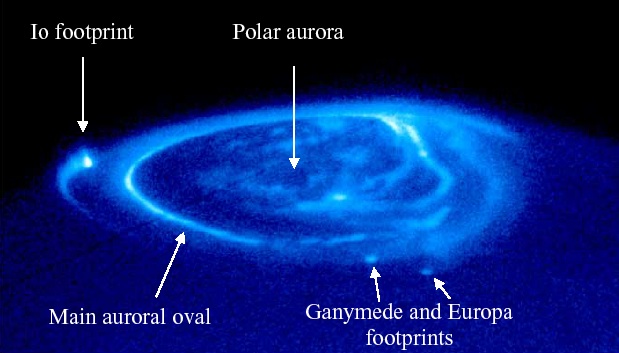Planetary Atmospheres and Space Sciences Group
Center for Space Physics, Boston University
Center for Space Physics, Boston University


Science Menu
Physics of Aurorae
Planetary magnetospheres
The magnetosphere is the cavity surrounding a planet or other magnetised body that contains and is controlled by the body's magnetic field. The size and shape of its boundary, known as the magnetopause, is governed to first order by the condition of pressure balance between the solar wind plasma, which flows radially away from the sun at speeds of ~500 km/s, on the one side and magnetic pressure on the other. The magnetosphere acts as an obstacle to the solar wind flow in the same way a large rock in a stream acts as an obstacle to the water. Thus, the action of the solar wind on the magnetosphere compresses the magnetic field on the dayside and drags it into a long comet-like magnetic tail, typically thousands of planetary radii in length, on the nightside. In addition, because the solar wind is highly supersonic with respect to the magnetosphere there exists a standing bow shock upstream of the magnetosphere, across which the solar wind is compressed, heated and slowed enough to flow around the magnetosphere in a region called the magnetosheath. In this manner, the magnetosphere effectively shields the planet from the vast majority of the solar wind plasma as it is not readily able to traverse the magnetopause into the magnetosphere. A fraction, however, does diffuse across the boundary and a process known as magnetic reconnection occurs in which the magnetic field threading through the solar wind plasma joins with the planetary magnetic field to form open field lines with one end fixed to the planet and the other open to the solar wind. Open field lines are dragged anti-sunward by the flow of the solar wind, where they eventually reconnect again and the resulting newly-closed field lines travel back to the dayside where the cycle repeats. This process is known as the Dungey cycle, after J.W. Dungey, who first proposed the mechanism in 1961. It is one of the two primary mechanisms that drive convection in a magnetosphere, the other being the rotation of the planet. The dominance of either of these processes determines the overall dynamics of each of the solar system’s various magnetospheres.-
Schematic of Jupiter's magnetosphere
Auroral emissions
-
Planetary auroras are a particularly useful diagnostic tool
for the
processes occurring within the magnetospheres of the other planets, as
they essentially provide two-dimensional representations of the events
happening within large volumes of space surrounding the planets. The
dynamics described above generate electric currents, i.e. flows of
charged particles such as electrons, that circulate around the
magnetosphere. In the polar regions of the planet these currents flow
into and out of the planet’s upper atmosphere, and streams of
energetic particles are caused to flow down the magnetic field lines,
impacting on the molecules in the atmosphere. On impact, the kinetic
energy of the particles is converted to other forms, such as heat and
excitation of the atmospheric particles. These excited particles then
release their extra energy as light. The colour, or wavelength, of the
light emitted depends on what particle it was emitted from. For
example, the visible green and red auroras on Earth are emitted by
oxygen and nitrogen in the upper atmosphere. At Jupiter and Saturn, the
dominant atmospheric particle is hydrogen, which emits in the
ultraviolet (UV) when excited by auroral electron impact. In order to
observe this UV emission we need to observe from above the
Earth’s atmosphere, and so we use the Earth-orbiting Hubble
Space
Telescope. From the study of these auroral emissions we can learn a
great deal about the other planets without even leaving Earth orbit.
Planetary auroras
-
The energy that drives the Earth’s auroras
ultimately derives
from the solar wind, which is a much more significant momentum and
energy source for the Earth’s magnetosphere than planetary
rotation. The processes associated with the Dungey cycle
drive
strong currents around the magnetic field and energise plasma such that
energetic charged particles flow into the polar ionosphere and generate
the auroras that have been observed on the ground for thousands of
years. The location and brightness of the Earth’s
auroras
are strongly dependent on the prevailing conditions in the solar wind,
known as ‘space weather’. During periods
of high
solar activity the Earth’s magnetosphere may be buffeted by
clouds of plasma emitted from the Sun, and under certain conditions
these can initiate magnetic storms, during which large amounts of
energy are transferred from the solar wind to the magnetosphere and
ionosphere, with the potential to take out satellites and pose problems
regarding astronaut safety as well as affect communications and
generate potentially damaging surges in power cables and
pipelines. The Earth’s auroras and the associated
magnetospheric dynamics have been studied extensively for decades from
both the ground and space and, although we now comprehend the overall
picture, there is a lot of the detailed physics that we still do not
understand.
-
The auroras of the outer planets have been studied relatively
little
in comparison to the Earth’s, and we are only just beginning
to
understand the big pictures of Jupiter and Saturn.
Jupiter’s magnetosphere is the largest object within the
solar
system and the dynamics of it are largely dominated by the fast ~10 hr
rotation of the planet. It turns out that the most
significant
component of Jupiter’s auroras, the main auroral oval, is
driven
by planetary rotation. The moon Io orbits deep within
Jupiter’s magnetosphere, where it is exposed to large tidal
forces as it is pulled around by the competing gravities of Jupiter and
the other Galilean moons: Europa, Ganymede, and Callisto.
These
tidal forces heat Io, such that it has become extremely volcanic, and
liberates from its volcanoes approximately one tonne per second of
sulphur and oxygen plasma into the space surrounding its
orbit.
This plasma feels the fast rotation of Jupiter’s magnetic
field
and is dragged around at the same rate as the planet. This
fast
rotation causes it to ‘fall’ away from Jupiter due
to the
centrifugal force, and in doing so it slows down in the manner of a
spinning ice skater slowing down as she extends her arms out
sideways. This results in a vast spinning disc of plasma that
rotates fast around Jupiter in the inner region and more slowly in the
outer region. Jupiter, however, attempts to keep all this
plasma
rotating at the same rate as it does, and the way in which it tries to
enforce this is by setting up an electric current system, one component
of which results in electrons bombarding Jupiter’s upper
atmosphere and causing the main oval auroras. This is not the
end
of the story, however; Jupiter also exhibits two other auroral
features: the moon footprints and the polar auroras. The moon
footprints are spots of auroral emission that are magnetically linked
to the Galilean moons. The brightest spot is that associated
with
Io, and it also exhibits a tail, or ‘wake’ that
traces
eastward around the planet. The exact details of the
processes
that lead to the formation of the footprints are still not understood,
but it is thought that they are a result of the moons’
interaction with the rotating magnetic field and the acceleration of
newly created plasma to the speed of the rotating field. The
polar auroras are still somewhat of an enigma, as they are the most
highly variable component of Jupiter’s auroras in terms of
brightness. The location and variation of these auroral
emissions
make it possible that at least some of them may caused by the solar
wind interaction, although this has yet to be proved.
-
Saturn’s auroras are different still from those of the Earth
and
Jupiter. Like the Earth’s they exhibit major
changes in
their form (‘morphology’) in response to changes in
the
solar wind but they are also influenced by the rapid ~10hr rotation of
the planet. Saturn exhibits an auroral oval that occasionally
takes the form of a spiral and sometimes appears to be constructed from
several separate ‘arcs’. In one striking
set of
images the auroras expanded to fill almost the entire dawn side of the
polar cap in response to a sharp increase in the
‘strength’
of the solar wind observed by Cassini as it approached the planet in
2004. One of the goals of the 2007 observation campaign is to
determine whether Saturn’s auroras are driven by internal or
external processes.
-
The following are examples of the images of Jupiter and
Saturn's UV auroras that have been obtained previously.

